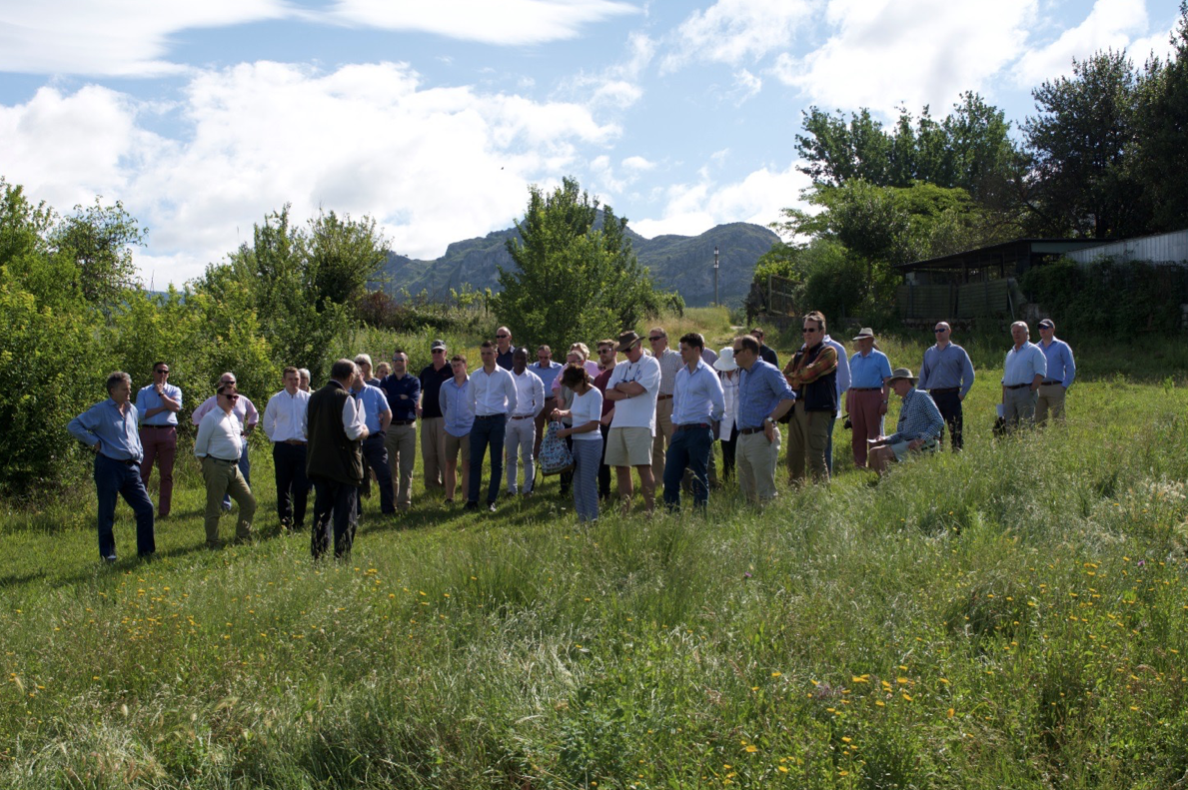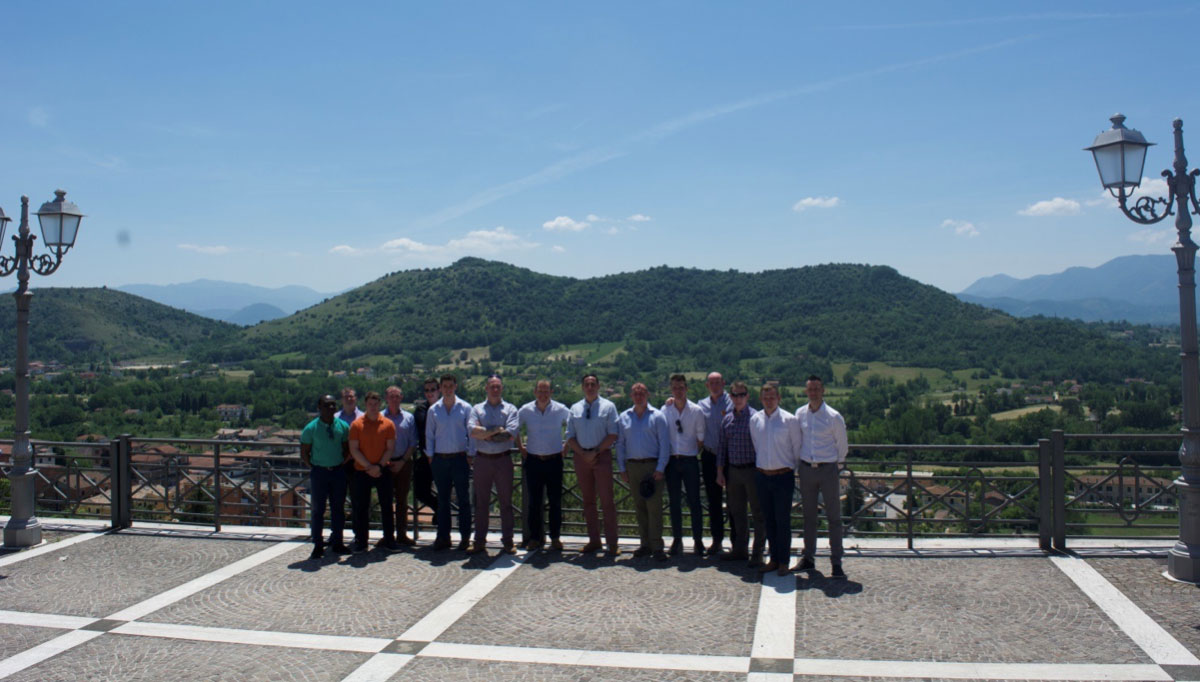From 19 – 24 May 2017 15 members of 1st Battalion Welsh Guards visited Italy for a battlefield study. This looked at the actions of the British and American forces between January and June 1944 including the battles of Monte Cassino and Monte Piccolo. There was particular focus on 3rd Battalion Welsh Guards (3WG) who served with distinction throughout the campaign. The tour was organised by JC Journeys and led by four retired officers: Maj Gen Roberts (Late Irish Guards), Maj Gen Cumming (Late 17/21st Lancers), Col Biggs (Late Coldstream Guards), and Maj Roberts (Late Irish Guards). All served in regiments which fought in the Italian campaign and possess considerable personal modern operational experience - their expertise proved vital to the educational aspect of the trip. Over the 6 days we visited a series of battle sites, several cemeteries and also had a cultural day in Rome.

The trip began with the 15 members of Battalion meeting the Regimental Adjutant and a cohort of retired Welsh Guards officers and members of the Drapers’ Company at Heathrow Airport to travel to Rome. There were 38 people in total in the party. The flight to Rome went without a hitch, bar Sgt Jones 51 being very briefly (and inexplicably) detained at Italian customs! After this we moved to our hotel in the town of Cassino for drinks and a brief on the Italian campaign as a whole and the events leading up to the battles we would focus on. Monte Cassino is a monastery on top of a hill which has commanding views over the entire of the Liri Valley which was the main south to north movement corridor towards Rome. This was the only way that allied forces could access Rome in a timely and logistically sound fashion. As such, the capture of Monte Cassino and the surrounding hills was deemed essential to allow the allied advance to continue and for Rome to be captured.
Our second day covered the initial battles for Cassino. A series of rivers south of the town of Cassino and overlooked by the monastery needed to be crossed in order to allow the town and then the high ground overlooking the valley to be captured. These crossings and the initial battles took place in January in horrendous weather conditions. Allied planners overlooked the scale of the German defences which consisted of a mile of positions in depth with obstacles and a comprehensive artillery fire plan. Needless to say, the crossing by both the British and Americans were largely unsuccessful and heavy casualties were sustained. After this failure, the advance focused on the high ground to the south-east of Cassino where free French forces and the Canadians began to claw back the mountainous terrain back from the Germans. Once the day’s studies had concluded, we visited the military cemetery in Cassino where 57 Welsh Guardsmen are buried. A brief service was held as well the laying of a wreath by Gdsm Todd.
The next day we continued with the study of the battles of Monte Cassino focusing on the second and third battles. These proved to be the bloodiest and most complicated fights of the battle. British troops approaching through Cassino from the south-east managed to gain a foothold in the town of Cassino and began advancing up the high ground towards the monastery from the south and east. It is impossible to look at the terrain and not be shocked at the difficulties that troops fighting up that ground must have suffered. Steep hills dominate with little or no cover in the face of pre-prepared positions manned by elite German units such as the Fallschirmjäger (paratroopers). To add to the complexity most operations were conducted at night and due to poor communications there were significant difficulties in coordination and synchronisation. This phase took up most of the day but we did manage to visit the monastery at Cassino itself late in the afternoon. It was entirely destroyed in 1944 and then built up from scratch after the war. The strategic position of the monastery became clear once we saw the view it offered over the Liri Valley. It definitely reinforced just how difficult it must have been to attack such ground. From there we moved to Rome, occupied a new hotel and prepared for the next day’s tours.

Col (Retd) Biggs briefs the group on the 3rd Battle of Cassino.
For the third day of the tour we moved away from the Cassino battlefield and on to Monte Piccolo. This battle is of immense significance for the Regiment as it is where 3WG was involved in some incredibly fierce fighting and sustained heavy casualties. This battle occurred on the high ground surrounding a road known as Route 6 which led to Rome. Monte Grande and Monte Piccolo are situated to the left of the road and Monte Oria to the right. These hills were the objectives of the 1st Guards Brigade comprising 3rd Battalion Grenadier Guards, 2nd Battalion Coldstream Guards and 3WG. The attack was conducted at night on 26 May 1944 and lasted for 3 days. In total the Brigade suffered 300 casualties with 112 of those coming from the Welsh Guards.
As we stood at the base of Monte Piccolo, the Regimental Adjutant read a very moving letter from the Commanding Officer of 3WG, Lt Col Gurney DSO MC to the then Regimental Lieutenant Colonel, Col Bankier DSO OBE MC about Lts Pip and Mick Bankier. Pip was killed in the battle for Monte Piccolo and his brother Mick was wounded. Col Bankier was their uncle.
On our the second day of the trip we had visited Pip’s grave at Cassino and hearing this letter read aloud really drove home the impact of the Italy campaign on our Regiment and the families of those who served.

The serving members of the battalion with Monte Piccolo in the background.
Our final day in Italy was the most relaxed! After a leisurely start we made our way to the Commonwealth War Graves Cemetery in Rome for the final service and the laying of a wreath. As 4 Welsh Guardsman were buried there it was a very poignant end to the tour. Once this was finished, the group enjoyed a half day cultural excursion into Rome itself and then a group dinner in the Piazza Navona, a great setting for our final dinner. The next day we departed Rome for Heathrow after a thoroughly enjoyable five days away.
Overall, the trip was a resounding success. We were very fortunate to have knowledgeable and experienced guides who gave an excellent insight into the activities of 3WG. Special thanks must go to Maj (Retd) Roberts and his wife Jane who organised all the transport, accommodation and day to day running of the trip. Their experience and flexibility was invaluable in ensuring the smooth running of the tour. Thanks must also go to Regimental Headquarters for organising those on the trip from outside of the Battalion. The healthy mix of Extra Regimentally Employed officers, retired officers and their wives and the Drapers made for a fantastic group dynamic. All who attended thoroughly enjoyed the trip and there is sure to be strong competition for spaces on next year’s trip!
WO2 (RQMS(T)) Griffiths 96 and Capt (Retd) Williams-Buckley.
